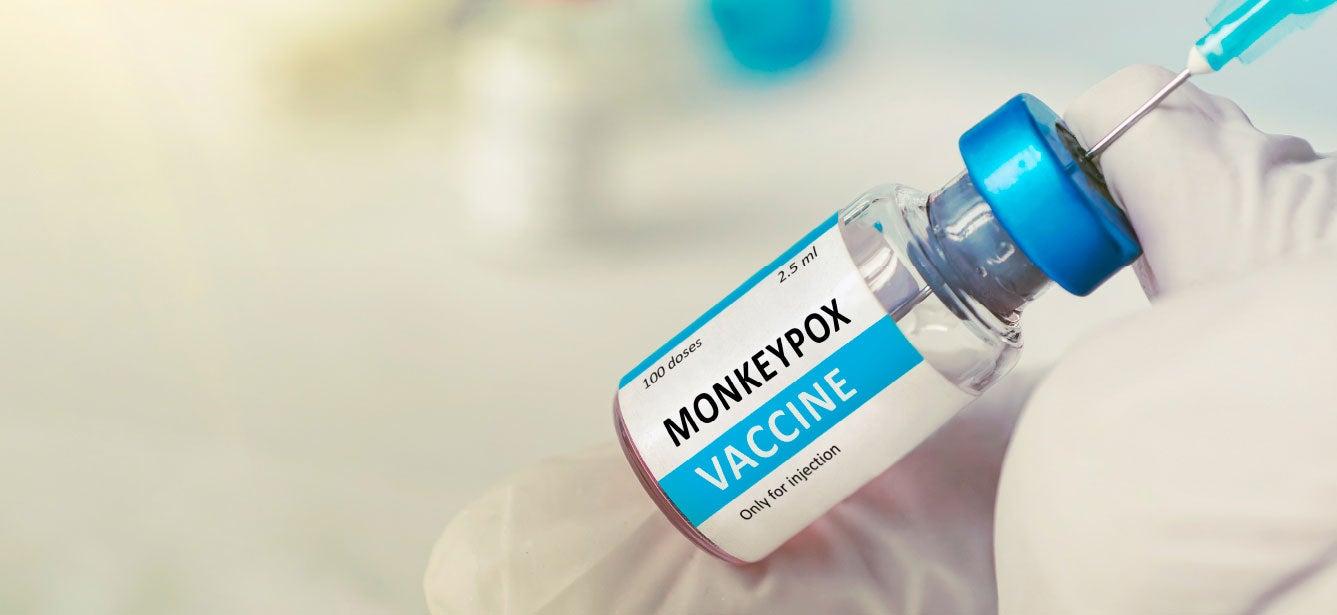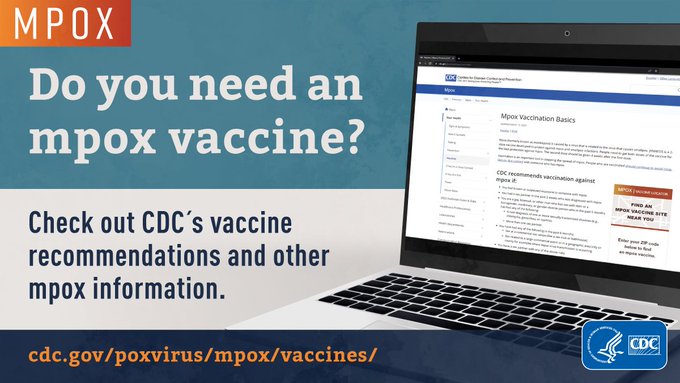
Related Topics
On May 18, 2022, the United States recorded the year’s first case1 of mpox, formerly called monkeypox, a rare disease2 caused by part of the group of viruses that cause smallpox. By late September, while older adults were rolling up their sleeves for an updated COVID-19 vaccine, the Centers for Disease Control and Prevention (CDC) had tallied 24,572 confirmed mpox cases.3
As Americans received news of another viral outbreak, the Annenberg Public Policy Center found in a survey that most people knew little about mpox. Even though the variant circulating is rarely fatal and much less transmissible than the coronavirus, mpox calls on all of us to stay well-informed and healthy—for ourselves, our families, and our communities.
“Every American should take [mpox] seriously, and every American must do their part to help us beat back [mpox],” Xavier Becerra, secretary of the U.S. Department of Health & Human Services, said in a press briefing.1
Here’s a roundup of news you can use, and share, to help slow and end this public health emergency.
What is the history of mpox (monkeypox)?
The virus was discovered in a Denmark laboratory in 1958 when several laboratory monkeys developed a pox-like rash. The first report of a human contracting mpox was in 1970, in the Democratic Republic of the Congo. Public health officials say the disease is endemic in some central and west African countries, and prior to this outbreak, mpox cases in the United States were “linked to international travel to countries where the disease commonly occurs or through imported animals,” the CDC says.2
How does mpox spread?
Mpox is transmitted through “close, personal, often skin-to-skin contact,” the CDC says. This includes direct contact with mpox rash, scabs, or body fluids from a person with mpox; touching objects, fabrics (clothing, bedding, or towels), and surfaces that have been used by someone with mpox; and contact with respiratory secretions.4
Mpox is zoonotic, which means animals can transmit it to people, but “monkeys are not a main source of transmission,” Yale University epidemiologist Saad Omer said in an interview with the Yale School of Medicine. “… it’s the rodents that we need to worry about in terms of actual transmission.”
In the U.S. in 2003, there were 47 “confirmed and probable” mpox cases linked to contact with pet prairie dogs, who arrived in a shipment of mammals that included several types of rodents.
What caused the 2022 mpox outbreak?
Public health officials are working to find the cause of the outbreak, which through Sept. 22 totaled 65,415 mpox cases worldwide. Just 580 of those cases originated in countries where the virus is known to circulate, the CDC says.3
“The identification in May 2022 of clusters of [mpox] cases in several non-endemic countries with no direct travel links to an endemic area is atypical,” according to WHO. “Further investigations are underway to determine the likely source of infection and limit further onward spread.”5
Is mpox life-threatening?
“Infections with the type of [mpox] virus identified in this outbreak—the Clade IIb—are rarely fatal,” the CDC says. “Over 99% of people who get this form of the disease are likely to survive. However, people with weakened immune systems, children under 8 years of age, people with a history of eczema, and people who are pregnant or breastfeeding may be more likely to get seriously ill or die.”6
When the Los Angeles, California, Department of Health reported the country’s first death to mpox in mid-September, officials said the individual who succumbed to the virus was “severely immunocompromised.”
Mpox and older adults
Through Sept. 22, demographic data show confirmed mypox cases for adults ages 61 and older were among the lowest recorded. The CDC reported 277 cases in that age group.
The CDC does not cite older age in itself as a risk factor for older adults, but of course, public health officials continue to stress that anyone who’s had close, personal contact with someone who has mpox is at risk.
“We are still pretty limited in our case index, but it has been almost exclusively seen here in men who have sex with men (MSM),” says Dr. Kenneth Koncilja, a geriatrician at the Cleveland Clinic in Cleveland, Ohio. “However, I would say this is probably drastically undercounting true case mix because there are probably many asymptomatic cases we are not seeing because they may be mild disease or just upper respiratory infection symptoms. People who are immunocompetent (normal immune systems) do much better and have milder disease than immunocompromised … patients.”
Who is at highest risk for mpox?
“At this time, data suggest that gay, bisexual, and other men who have sex with men make up the majority of cases in the current [mpox] outbreak,” the CDC says. “However, anyone, regardless of sexual orientation or gender identity, who has been in close, personal contact with someone who has [mpox] is at risk.”3
WHO officials also emphasize that “the risk of [mpox] is not limited to people who are sexually active or men who have sex with men.”
“Given that the virus is currently moving from person to person in these social networks, men who have sex with men may currently be at higher risk of being exposed if they have sex or other form of close contact with someone who is infectious. People who have multiple or new sexual partners are currently most at risk,” WHO officials say.7
Recognizing mpox symptoms
A sometimes-painful rash is the most common symptom of the mpox virus. It can appear and spread on or near the genitals or anus, or on other areas of the body like the hands, feet, chest, face, or mouth. The mpox rash goes through several stages, including scabs, before healing.8
Flu-like symptoms are other signs of infection. These can include fever, chills, swollen lymph nodes, exhaustion, muscle aches and backache, headache, and respiratory symptoms.
If you think you have symptoms or have been in close contact with someone who has the virus, talk to your doctor about whether you should be tested.
If you have been exposed, watch for mpox symptoms for 21 days from the date of exposure.8
How do you prevent mpox?
You can help protect yourself and others by following these CDC-provided guidelines:9
- Avoid close, skin-to-skin contact with people who have a rash that looks like mpox. Do not touch the rash or scabs of a person with mpox. Do not kiss, hug, cuddle, or have sex with someone with mpox.
- Avoid contact with objects and materials that a person with mpox has used. Don’t share eating utensils or cups with a person with mpox. Don’t handle or touch the bedding, towels, or clothing of a person with mpox.
- Wash your hands often with soap and water or use an alcohol-based hand sanitizer, especially before eating or touching your face and after you use the bathroom.
“One misconception I hear is some believe once the pox scab over they are not contagious. That may be the case with chickenpox, but with [mpox] the scabs still shed virus,” Koncilja says. “We are told to maintain isolation and contact precautions for the duration of the pox presence at this time. More will probably be made known about viral load and exposure rate.”
What if I get mpox?
“There is currently no treatment specifically for mpox,” the CDC says. “Because the viruses that cause mpox and smallpox are closely related, drugs and vaccines developed to treat and protect against smallpox may be effective for [mpox].”10
Even without a specific mpox treatment, there are a number of ways to manage your symptoms, including getting plenty of rest. Most people recover within 2-4 weeks.
Should I get an mpox vaccine?
It may be advisable to get the mpox vaccine, the CDC says, “if you have been identified as a close contact of someone with mpox or you learn that one of your sex partners in the past 2 weeks has been diagnosed with [mpox].” Your health care professional or local health department can offer guidance and more information about Jynneos, the two-dose vaccine developed to protect against smallpox and mpox.11
“The only people I’ve given specific advice on the [mpox] vaccine were to men who have sex with men, who have HIV, and who are still sexually active,” Koncilja says. “These are some of the highest risk patients and candidates for smallpox vaccine. This has been a narrow focus and likely will need to change in the future as we better identify the true population incidence.”
How to stay informed about mpox
Dr. Demetre Daskalakis, the National Monkeypox Response deputy coordinator, recently shared some encouraging news: “ … back in July, CDC estimated that it took eight days for cases to double nationwide. By mid-August, the doubling rate was 25 days, showing encouraging signs of progress.”
You can keep up with developments and guidance on the CDC website, a trusted source for information on topics ranging from mpox prevention to mpox treatment. Data is updated frequently. WHO offers a comprehensive FAQ and a global perspective. And as always, if you have any health concerns, talk to your doctor.
There’s another important step you can take right now to safeguard your health, Koncilja says, and that’s get a flu shot.
“I can't begin to emphasize enough the concerns of the health care community of the risk of multiple respiratory viruses endemic during the upcoming winter season," he said, stressing the importance of getting your yearly flu vaccine. "Readers should know about the Southern Hemisphere's influenza season this summer. It's highly concerning with many prognostic factors leading towards a worse influenza season than we typically have.”
“Our health care system is stressed beyond belief. This is my biggest personal concern with [mpox].”
This article was updated in December 2022 to reflect this World Health Organization recommendation to use the term 'mpox' to refer to the disease commonly known as monkeypox.
Sources
1. The White House. Press Briefing by White House Monkeypox Response Team and Public Health Officials. Aug. 11, 2022. Found on the internet at https://www.whitehouse.gov/briefing-room/press-briefings/2022/08/11/press-briefing-by-white-house-monkeypox-response-team-and-public-health-officials/
2. Centers for Disease Control and Prevention. What Is Monkeypox? July 22, 2022. Found on the internet at https://www.cdc.gov/poxvirus/monkeypox/about/index.html
3. Centers for Disease Control and Prevention. 2022 Monkeypox Outbreak Global Map. Sept. 23, 2022. Found on the internet at https://www.cdc.gov/poxvirus/monkeypox/response/2022/index.html
4. Centers for Disease Control and Prevention. How It Spreads. July 29, 2022. Found on the internet at https://www.cdc.gov/poxvirus/monkeypox/if-sick/transmission.html
5. World Health Organization. Monkeypox. May 19, 2022. Found on the internet at https://www.who.int/news-room/fact-sheets/detail/monkeypox
6. Centers for Disease Control and Prevention. Frequently Asked Questions. Sept. 13, 2022. Found on the internet at https://www.cdc.gov/poxvirus/monkeypox/about/faq.html
7. World Health Organization. Monkeypox. August 31, 2022. Monkeypox Q&A. Found on the internet at https://www.who.int/news-room/questions-and-answers/item/monkeypox
8. Centers for Disease Control and Prevention. Signs and Symptoms. August 5, 2022. Found on the internet at https://www.cdc.gov/poxvirus/monkeypox/symptoms/index.html
9. Centers for Disease Control and Prevention. How to Protect Yourself. July 29, 2022. Found on the internet at https://www.cdc.gov/poxvirus/monkeypox/prevention/protect-yourself.html
10. Centers for Disease Control and Prevention. What to Do if You’re Sick. Aug. 11, 2022. Found on the internet at https://www.cdc.gov/poxvirus/monkeypox/if-sick/what-to-do.html
11. Centers for Disease Control and Prevention. Monkeypox Vaccination Basics. Aug. 30, 2022. Found on the internet at https://www.cdc.gov/poxvirus/monkeypox/vaccines/vaccine-basics.html




